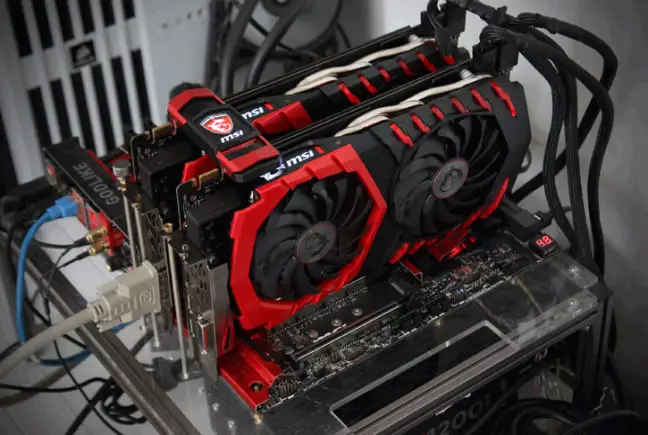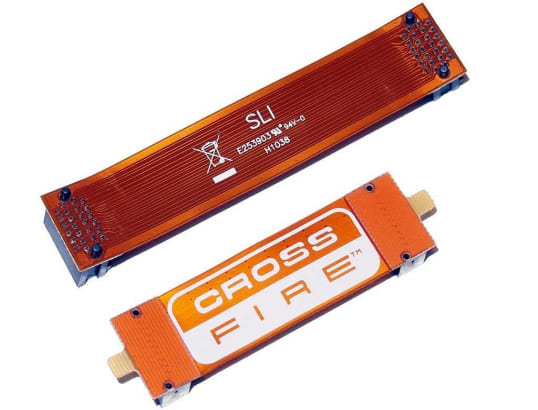The Truth About Two different GPUs in One PC
You see all these realistic games and like to play them on your PC, but you’re unsure if your GPU is powerful enough.
You’ve heard that having two different graphic cards in one computer can increase performance, but is it really possible?
Similarly, if you do media editing and have seen using multiple GPUs simultaneously working to speed up rendering times, is it practicable?
Hey, in this article, I’m going to explore the topic of having two GPUs in one PC and see if it’s something that can truly benefit your experience.
2 Different Graphic Cards in one PC?
First, it is possible to run two graphics cards on the same motherboard!
Having two different GPUs in a single computer is known as SLI (Scalable Link Interface) or CrossfireX, depending on whether you have NVIDIA and AMD cards. These technologies help you create a multi-GPU setup to work together in a single system.

Installing two or more GPUs in one computer system creates a parallel processing platform that can share the workload to get more power and speed rather than one card. For example, one card handles a game’s physics while the other takes the textures, having more capabilities.
In the case of media, exporting time like tasks can be reduced by utilizing both GPUs simultaneously.
Running Multiple Graphics Cards for Gaming
Running two GPUs in one computer is possible, but having both GPUs running simultaneously in a single game isn’t as simple as it seems. This is something more complex and involves specific configuration and compatibility matters.
Here are a few considerations for utilizing the power of both GPUs in just one game:
First and foremost, your motherboard must support technologies like SLI for NVIDIA GPUs or CrossfireX for AMD GPUs to use multiple GPUs effectively. Otherwise, the second GPU won’t be recognized by the system.
Many high-end motherboards come with multiple PCIe slots (x8 or x16 bandwidth) to install more than one graphics card to configure SLI/Crossfire technologies.
Secondly, all the GPUs must be the same model and from the same manufacturer. Traditionally seen, mixing different models within a multi-GPU setup could lead to issues with performance or even system instability, And with other brands, it won’t even be possible.
Also, not every graphic board natively supports SLI/Crossfire. So, it’s essential to check each GPU’s specifications and ensure they are compatible with these technologies. Some examples of GPU have SLI and Crossfire supporting Multi-GPU setup as per the mentioned manual:
- RTX 3090 & Ti
- Radeon RX 6900 XT
- RTX 2080, Ti & SUPER
- Radeon RX 6800 XT OC
- Radeon RX 5700 XT
- GTX 1080 & Ti
- GTX 1070
AMD provides more flexibility in choosing compatible graphics cards, they must be from the same series for dual setup.
Tip – Use your manual guide to check if the GPU supports SLI or Crossfire. In addition, community forums can provide insights into specific GPU combinations that users have successfully used in such configurations.
Further, to enable data transfer via SLI or CrossfireX, you would also need to connect both GPUs using an SLI bridge for NVIDIA cards or a Crossfire cable for AMD GPUs.

Keep an eye on whether the existing power supply can handle the power requirements for the second GPU. Mid to higher-end graphics units with high CUDA cores can consume a lot of power, especially when overclocked, and running two of them in tandem will significantly increase the power requirements. Ensure the PSU is sufficient to supply power to both GPUs simultaneously.
Once all the requirements have been met, you are good at using your multi-GPU setup.
Before you dive into using your multi-GPU setup, the other performance side of the story should also be taken care of.
Limitations to Run 2 Graphics Cards for Gaming
1. Not all Games support SLI & Crossfire
The first limitation is that not all games support SLI or Crossfire, so you won’t be able to utilize both GPUs’ full potential in every titles. Games are programmed to use a single graphics board for processing. Hence, it may not recognize or utilize both cards.
Although most AAA games nowadays support SLI/CrossfireX, it’s worth checking their compatibility before setting up multiple GPUs. You can find these details on community forums or by contacting the game developers directly.
2. Driver Compatibility
Another limitation is related to driver compatibility. You would need a respective drivers for your GPUs. However, sometimes, there can be issues with driver compatibility between the 2 GPUs. This can cause crashes or other gaming performance issues.
To avoid this, it’s important to keep your drivers up-to-date and ensure they are compatible. You can check for known issues or compatibility patches on the manufacturer’s websites.
3. Performance Gains
Combining two different GPUs doesn’t necessarily double the performance. In fact, the performance gains can vary significantly depending on various factors such as game optimization, driver support, and hardware compatibility.
Generally, you can expect a 50-80% increase in performance with 2 GPUs compared to a single GPU.
In rare cases, you may see diminishing returns where the second graphic unit doesn’t provide a significant performance boost. However, one can do tweaking to enhance the performance.
4. Increased Cooling Requirement
Running multiple GPUs will not only consume more power but also generate more heat. Proper cooling is essential to prevent overheating and possible damage to your hardware.
It’s recommended to have a high-quality power supply unit (PSU) as well as good ventilation in your PC case when employing multiple GPUs, and see whether both the GPU sags due to weight of dual cards at once.
Should you have Run two Graphic Cards for Gaming?
Using two cheaper GPUs instead of one expensive card can be a great option for potentially better performance at a lower cost. But purchasing a new graphics card solely for these purposes may not be cost-effective, and one should know their specific use case before implementing the solution, such as:
If building a new PC, I suggest having one powerful graphics card might be a better choice. However, if you already have a good graphics card supporting SLI/Crossfire, adding a second one could be a viable option.
If you’re considering this setup, be prepared for the issues mentioned earlier, from driver compatibilities to increased power consumption and heat. You can also surf forums and community discussions to see if others have successfully used similar configurations with the specific video cards and applications you plan to use.
Running Multiple Graphics Cards for video editing or 3D rendering
Another situation where a multi-GPU setup makes sense is if you are using your computer for tasks other than gaming, such as video editing or 3D rendering, to accelerate speed.
Video editing software, such as Adobe Premiere Pro or DaVinci Resolve, can benefit from multiple GPUs. Still, the extent of the benefit depends on the tasks being performed. Also, not all video editing software is optimized for multi-GPU setups, and the performance gain may not always justify the additional cost of a secondary GPU.
Furthermore, 3D applications like Autodesk Maya, Blender, or Cinema 4D can benefit greatly from multiple GPU setup. These applications are designed to distribute rendering tasks across multiple GPUs, saving more time.
Many professional users involved in 3D animation production are often seen with multi-GPU setups to accelerate their workflow.
Final Thoughts
In conclusion, while multiple GPUs have benefits in specific scenarios like 3D rendering, the decision to use them for gaming or video editing should be carefully evaluated based on the current state of software support and cost-effectiveness.
Initially, multi-GPU was a popular solution to improve overall game performance and graphics quality.
But today, in recent years, the popularity of multi-GPU configurations has diminished, and fewer graphics board manufacturers are opting to design their cards with SLI or Crossfire support.
This is because most modern games are not optimized for multi-GPU setups, and there isn’t much demand in the market as the rise of powerful single GPUs exists.
FAQs
Where does a dual GPU setup make more sense?
The dual GPU setup situation makes sense more when you already have a high-end GPU and want to improve your performance without replacing it entirely. In this case, adding a second budget GPU in SLI/Crossfire mode can provide a noticeable boost in performance without breaking the bank.
Are dual graphics cards better than one for gaming?
With the declined support for SLI and Crossfire in recent games and limited compatibility, dual graphics card PCs might not be sensible for gaming today. In comparison, multiple video card systems could still be valuable for content creators, such as those involved in rendering tasks, where additional GPU horsepower can be worthwhile.
Can streamers utilize a 2 GPU in a single computer to reduce the load on the primary GPU?
Streamers can have 2 GPUs in use, one for better video recording quality as the main encoder for their video streaming software, such as OBS, while playing games on the other; this will ease some load from the primary GPU.
Can you use an old spare GPU to run additional monitors alongside your primary GPU?
If you have an old spare GPU card with ports, you can install it on the motherboard to connect additional monitors alongside your primary GPU. This setup is particularly useful who require many screens for their work.
What is an alternative to SLI and Crossfire?
EMA (Explicit Multi-Adapter) can be useful when traditional multi-GPU technologies like Crossfire and SLI (from AMD and Nvidia) are unsupported or feasible due to differences in GPU architectures or specs. EMA relies on DirectX 12, so it becomes relevant when running games or applications supporting this graphics API.
[Related]
- What are the Disadvantages of Liquid Cooling System for CPU?
- Why my DRAM light on motherboard blinks?
Is Overclocking Monitor Safe? Does it Reduce its Lifespan?
- How Much VRAM do you Need For Gaming (1080p, 1440p, 4k)?
